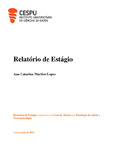| dc.contributor.advisor | MONTEIRO, LUÍS MANUEL COELHO | |
| dc.contributor.author | Lopes, Ana Catarina Martins | |
| dc.date.accessioned | 2023-08-02T10:52:21Z | |
| dc.date.available | 2023-08-02T10:52:21Z | |
| dc.date.issued | 2023 | |
| dc.identifier.uri | http://hdl.handle.net/20.500.11816/4245 | |
| dc.description.abstract | As alterações emocionais desencadeadas por uma lesão encefálica adquirida (LEA) são apontadas como umas das mais incapacitantes. Esta limitação está, inclusivamente, associada a uma tomada de decisão (TD) prejudicada, sobretudo com base na hipótese dos marcadores somáticos que propõe que, perante uma escolha, respostas antecipatórias de condutância elétrica da pele (CEP) orientam a TD vantajosa. Porém, indivíduos com LEA apresentam um padrão de reatividade fisiológica periférica (RFP) baixo.
Objetivo: Verificar a capacidade de TD em indivíduos com LEA, bem como analisar a influência da RFP nesse processo cognitivo.
Método: Participaram no estudo um grupo LEA (n = 31), heterogéneo quanto ao tipo e localização da lesão, e um grupo de controlo (n = 31). Para traçar o perfil de RFP, os participantes visualizaram 12 imagens emocionalmente evocativas, selecionadas do International Affective Picture System (IAPS), enquanto era recolhida em contínuo e em simultâneo a CEP. A avaliação da TD foi efetuada com recurso ao Iowa Gambling Task (IGT), Wisconsin Card Sorting Test (WCST) e Ultimatum Game (UG).
Resultados: Apesar da reduzida RFP no grupo LEA, não foram encontradas diferenças estatisticamente significativas entre ambos os grupos para a TD. Curiosamente, o grupo LEA apresentou um melhor desempenho no WCST.
Conclusões: À semelhança de estudos recentes que têm indicado críticas à hipótese dos marcadores somáticos, os nossos resultados não permitem fornecer evidências sobre a mesma. Consideramos, por isso, serem necessários mais testes aos pressupostos desta teoria. | pt_PT |
| dc.description.abstract | Emotional changes triggered by an acquired brain injury (ABI) are identified as one of the most disabling sequels. This limitation is also related to an impaired decision making (DM) capacity, especially if we consider the somatic markers hypothesis which proposes that, when faced with a need to choose, anticipatory skin conductance responses (SCR) guide a more advantageous DM. However, individuals with ABI have a low peripherical physiological reactivity (PPR) pattern.
Aim: To verify the ability of DM in individuals with ABI, as well as to analyze the influence of PPR in this cognitive process.
Method: Participants were divided in two groups, ABI (n=31), heterogeneous regarding lesion typology and location, and Controls (n=31). To determine PPR profile, 12 emotionally evocative images, selected from the International Affective Picture System (IAPS), were shown to all, while the SCR was registered. DM capacity was assessed using the Iowa Gambling Task (IGT), Wisconsin Card Sorting Test (WCST) and Ultimatum Game (UG).
Results: No significant differences were found between the two groups for DM capacity, despite the lower PPR in ABI group. Curiously, the ABI group performed better at WCST.
Conclusion: Like other recent studies that have found no evidence of the somatic markers hypothesis, our results haven’t either. We consider, therefore, that further testing of the assumptions of this theory is necessary. | pt_PT |
| dc.language.iso | por | pt_PT |
| dc.rights | info:eu-repo/semantics/openAccess | pt_PT |
| dc.subject | Lesão encefálica adquirida | pt_PT |
| dc.subject | Condutância elétrica da pele | pt_PT |
| dc.subject | Reatividade fisiológica periférica | pt_PT |
| dc.subject | Hipótese dos marcadores somáticos;tomada de decisão | pt_PT |
| dc.title | São as Nossas Decisões Puramente Racionais? Um Estudo na Lesão Encefálica Adquirida | pt_PT |
| dc.type | info:eu-repo/semantics/masterThesis | pt_PT |
| dc.identifier.tid | 203329856 | pt_PT |
| thesis.degree.name | Mestrado em Psicologia da Saúde e Neuropsicologia | pt_PT |


